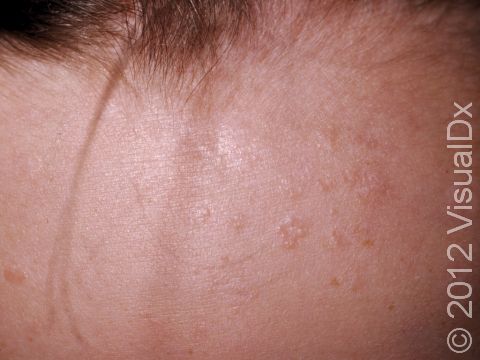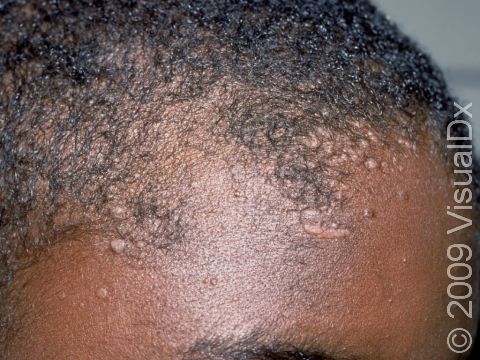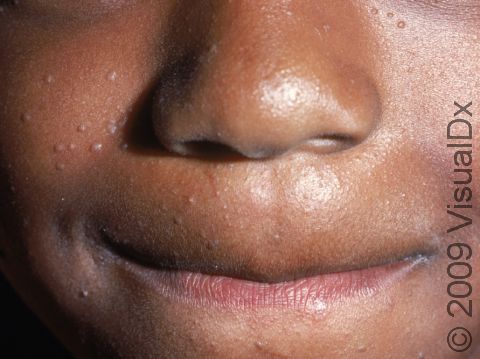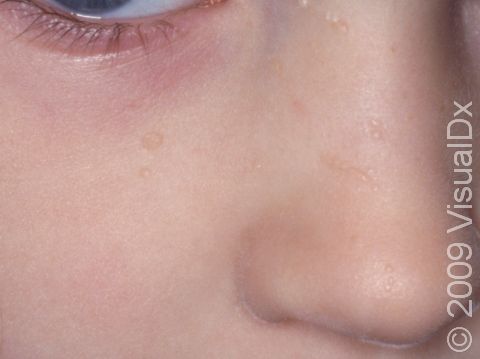Flat Wart
Flat warts (verruca plana) are caused by 3 strains of the human papillomavirus. These warts are raised slightly off the skin and are usually less than 3 mm in diameter. They can be pink or brown. The most common distribution on the skin is on the face, arms, back sides of the hands, and knees. Sometimes several warts may be in a line from the infant scratching his or her scalp line or from combing of the infant’s hair. Flat warts are typically small in size but can be numerous in a particular area. They will usually go away on their own without any treatment.
Who's At Risk?
Warts can be found in all ages and populations of people, but they seem to be most common in children aged 12–16 years. Infants may acquire warts through a tiny break in their skin if they come into contact with another person (eg, a caregiver) with warts. It is very rare for an infant to develop a wart after touching an object that was handled by another person with warts. However, flat warts may spread more quickly on infants, since infants might scratch at the warts, unknowingly causing more warts to form near the same area.
Signs & Symptoms
The most common locations for flat warts include:
- Face, especially in children
- Neck
- Backs of hands
- Arms
- Legs, especially in women who shave
- Beard area, especially in men who shave
Flat warts are very slightly raised, smooth, skin-colored bumps ranging in size from 1–5 mm.
Infection with flat warts can be graded as:
- Mild – One or a few painless warts
- Moderate – 10–100 lesions, which are painless
- Severe – More than 100 lesions, which cause enough pain to limit normal life activities
Self-Care Guidelines
Since many warts go away without treatment, it is not necessary to treat most warts. Warts also often come back (recur) or appear in new areas despite treatment; therefore, it is important to avoid using repeated, painful, or scarring treatments unless the warts are interfering with your child’s daily life.
Before trying any self-care measures, your child’s doctor should see him or her. Although it may take 6–12 weeks to get rid of (eradicate) the lesions, your child might find the following self-care measures helpful for non-genital and non-facial warts:
- Over-the-counter wart removers have a high percentage of salicylic acid and work by dissolving away the layer of skin infected with the virus. This treatment needs to be used daily and can sometimes be irritating if it touches unaffected skin around the wart.
- Duct tape applied daily to the affected area seems to work for unknown reasons. The tape should be very sticky and kept on for a few days. Some children may have a reaction to the adhesive on the tape.
- Over-the-counter freezing medications are available but have not been found to be very effective.
- Coupled with the above therapies, the wart should be soaked in warm water, and any loose skin should be removed every few days with a mild abrasive, like a pumice stone.
- Family members should avoid sharing personal items such as towels.
Treatments
Once your child has been diagnosed with flat warts, the physician may recommend one or more of the following treatments:
- Freezing with liquid nitrogen (cryosurgery)
- Burning with an electric needle (electrocautery)
- Using a laser to disrupt the blood supply of the warts
- Application of cantharidin, podophyllin, or salicylic acid applied in the office
- Application of tretinoin at home
- Injection with bleomycin, a chemotherapy drug, directly into the warts
- Application of imiquimod, a cream that induces the immune system to destroy the wart
Visit Urgency
Any infant with warts should be checked by the doctor.
References
Bolognia, Jean L., ed. Dermatology, pp.1223, 1226-1227. New York: Mosby, 2003.
Freedberg, Irwin M., ed. Fitzpatrick’s Dermatology in General Medicine. 6th ed. pp.2121, 2123-2124, 2128-2129. New York: McGraw-Hill, 2003.
Last modified on August 16th, 2022 at 2:44 pm

Not sure what to look for?
Try our new Rash and Skin Condition Finder



